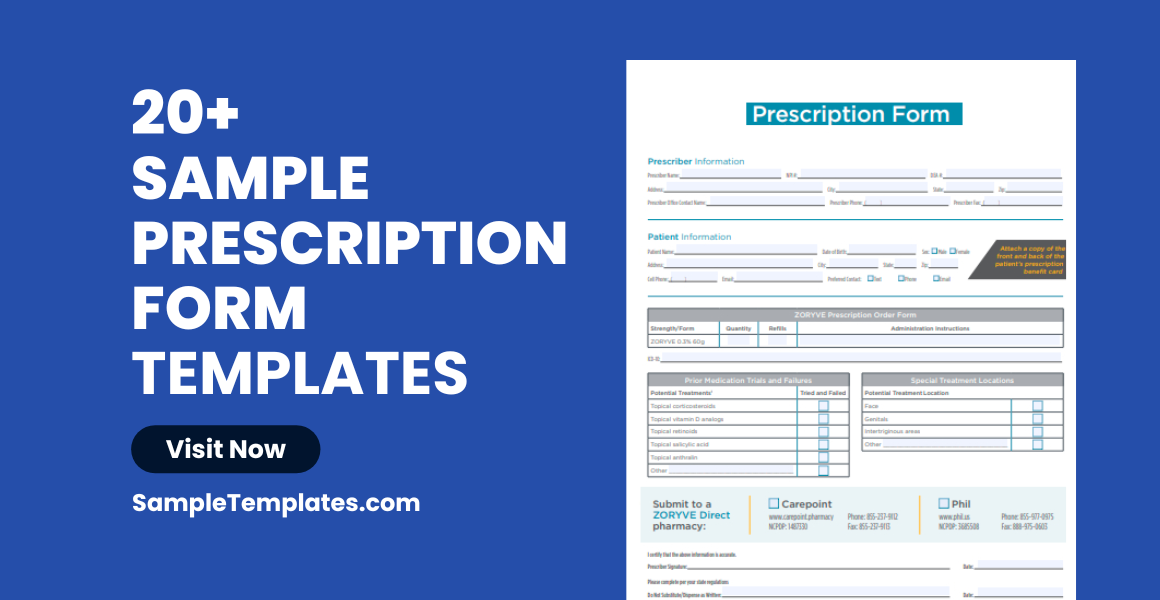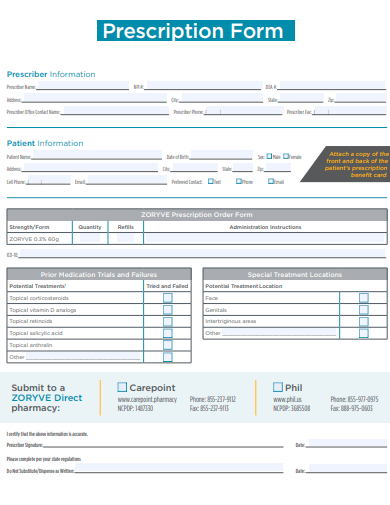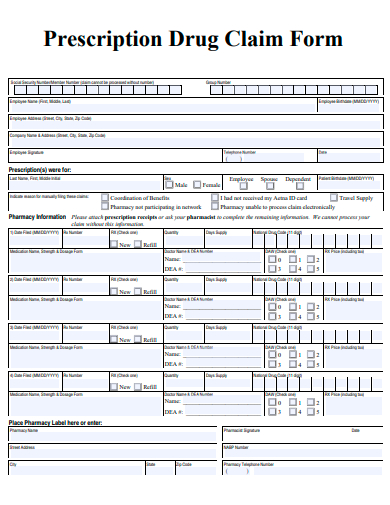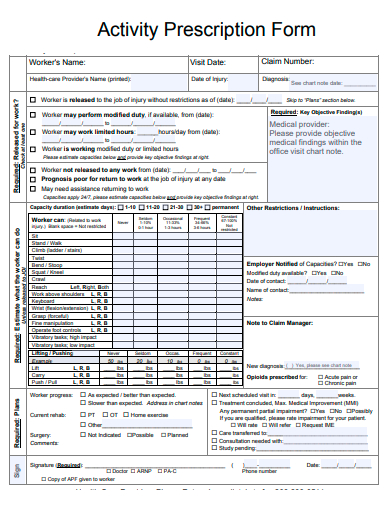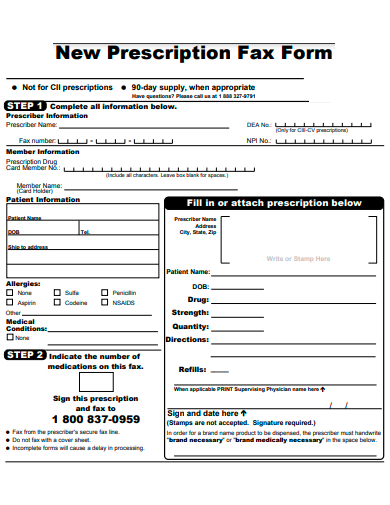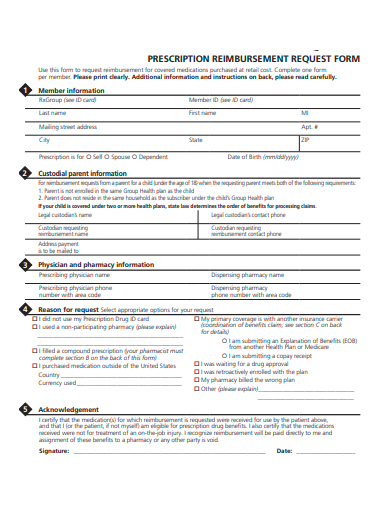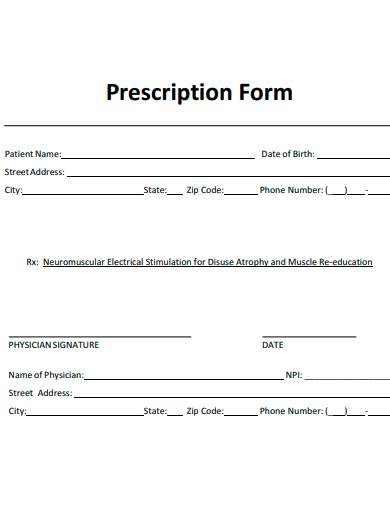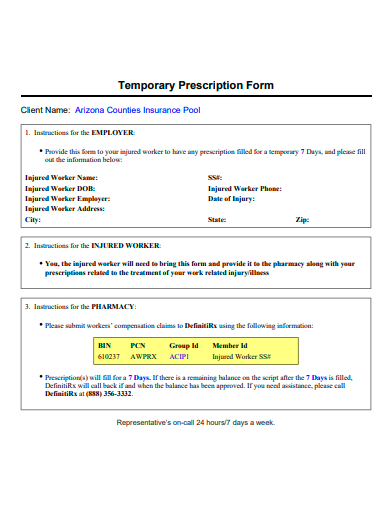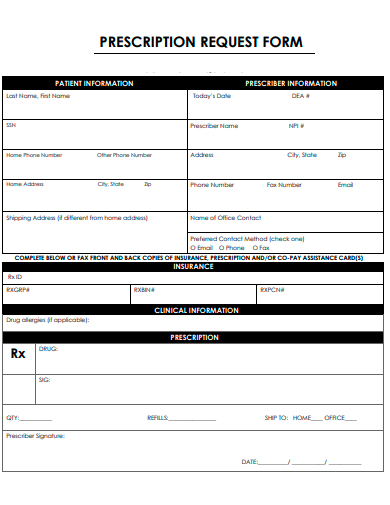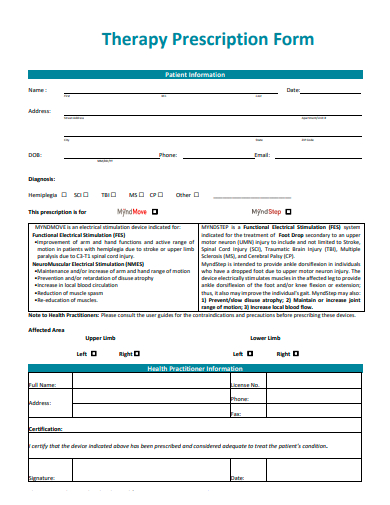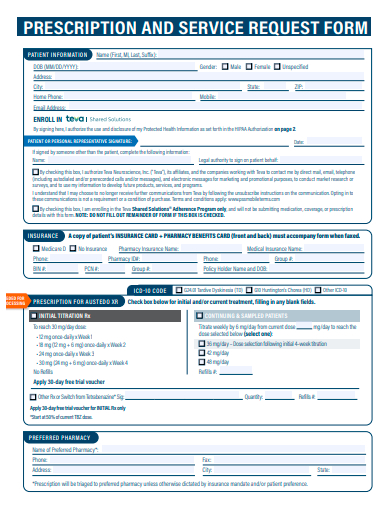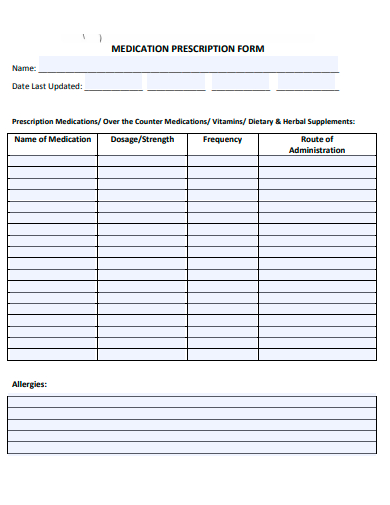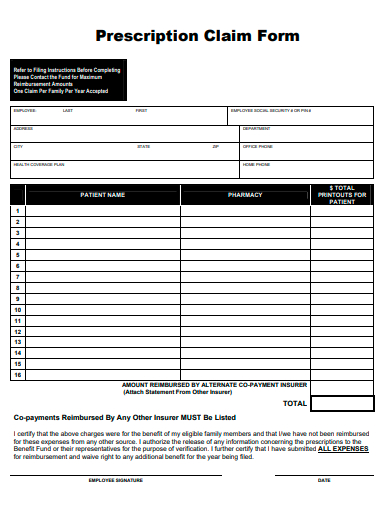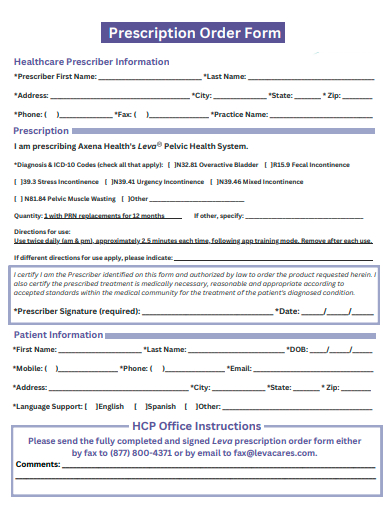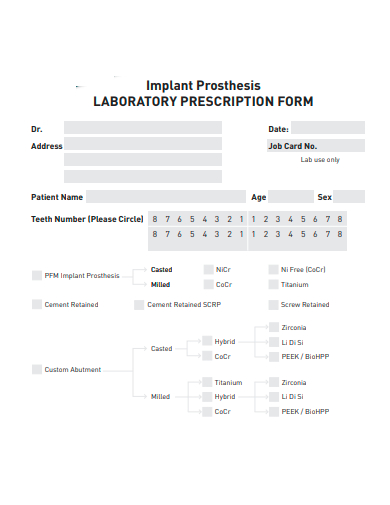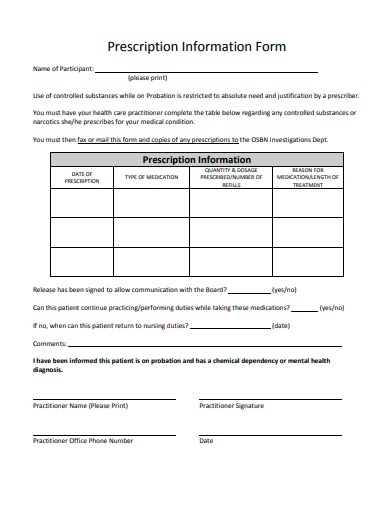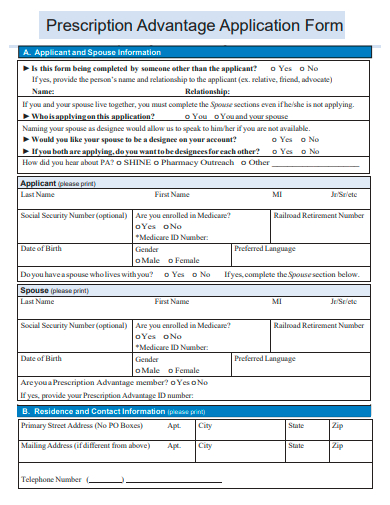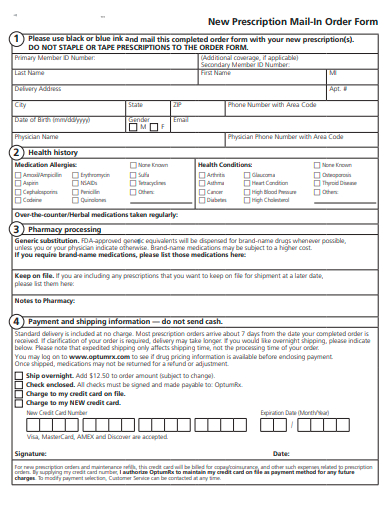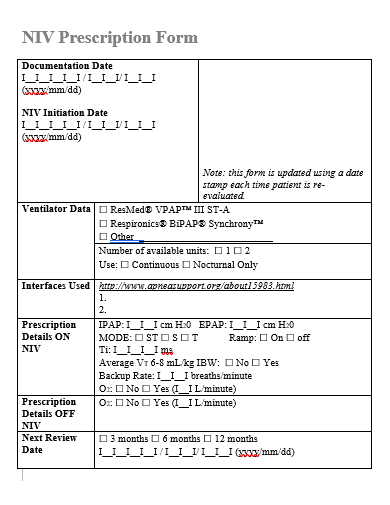In the meticulous world of healthcare, the ‘Prescription Form’ is indispensable. Serving as a conduit between medical professionals and patients, it ensures accurate communication of medication, dosage, and instructions. Beyond just medicines, a comprehensive Prescription Sample Form can be a lifeline, preventing potential drug interactions and ensuring therapeutic efficacy. Dive into our guide to appreciate its significance, layout nuances, and the vital role it plays in patient safety and optimal health outcomes.
20+ Prescription Form Samples
1. Sample Medical Prescription Form Format Template
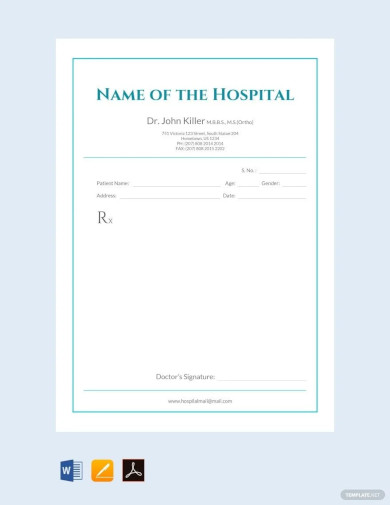
2. Sample Prescription Form Template
3. Sample Prescription Drug Claim Form Template
4. Sample Activity Prescription Form Template
5. Sample New Prescription Fax Form Template
6. Sample Prescription Transfer-In Form Template
What is a Prescription Form?
A prescription form is a legal design document provided by a licensed medical professional to authorize the dispensing of specific medications to a patient. It is an essential element in the medical world, bridging the gap between a physician’s diagnosis and the pharmacist’s dispensing of the required drugs.
Understanding the Basics
At its core, a prescription form contains detailed instructions concerning the drug a patient should take, how they should take it, and for how long. It’s not just a piece of sample paper but a reflection of a medical decision based on a patient’s health needs.
The Importance in Modern Medicine
In today’s complex world of medicine, prescriptions ensure that patients receive the right medication, at the right dose, for the right duration. They also provide a legal and professional record of a patient’s care.
A Cornerstone of Modern Medicine
Prescription forms have been an integral part of healthcare for generations. These legal documents, written or e-prescribed by licensed medical professionals, hold more significance than just indicating which medication a patient needs to take. Let’s delve into why these professional forms are of paramount importance in the realm of healthcare.
Ensuring Correct Medication
One of the primary functions of a prescription form is to ensure that a patient receives the correct medication. The form specifies not only the drug but also its dosage, form (tablet, liquid, etc.), and the frequency at which it should be taken. This ensures the patient gets precisely what the doctor intended.
Patient Safety and Prevention of Drug Interactions
Doctors consider a patient’s entire health profile, including other medications they may be taking, before writing a sample prescription. This is crucial to prevent potential drug interactions, which can be harmful or even fatal. A prescription form is a documented evidence of this process and helps pharmacists double-check for interactions when dispensing medication.
Legally Binding Authorization
In many jurisdictions, pharmacies are legally required to have a valid prescription before dispensing certain medications, particularly controlled substances. This safeguard ensures that these drugs are used appropriately and do not end up being misused or abused.
A Record of Medical Care
Prescription forms also serve as a record of the care a patient has received. This can be useful in multiple scenarios: tracking a patient’s medical history, understanding their drug regimen if they visit a new doctor, or even in legal situations where there’s a need to verify that a doctor prescribed a particular medication.
Ensuring Proper Dosage
Different patients might require different dosages of the same medication based on their age, weight, health conditions, or other medications they might be taking. A medical prescription form details the exact amount of medication a patient should take, ensuring they receive the therapeutic benefits without the risks of an overdose.
Facilitating Patient Education
Often, prescriptions come with additional sample notes and instructions from the doctor, such as when to take the medicine, dietary restrictions, or potential side effects to watch out for. This helps in educating the patient about their treatment and ensuring they’re well-informed.
Prevention of Medication Abuse
With the rising concerns about opioid epidemics and the abuse of certain medications, prescriptions play a pivotal role in controlling who has access to these drugs. It’s harder for individuals to obtain these medications without a legitimate reason, thanks to the need for a proper medical prescription.
The Evolution of Healthcare Technology
With the advent of electronic prescriptions, there’s an added layer of security and efficiency. E-prescriptions can be sent directly to pharmacies, reducing the chance of errors from misreading handwriting. They also facilitate easier tracking of a patient’s medication history.
Components of a Prescription Form
A typical prescription form includes the following details:
- Patient Information: This consists of the patient’s name, age, gender, address, and contact details. It ensures that the medication goes to the correct individual.
- Doctor’s Information: Essential for verifying the authenticity of the doctor prescription. It includes the doctor’s name, qualification, license number, and contact details.
- Date and Time of Prescription: This helps pharmacists ensure that prescriptions are filled promptly and aids in tracking medication history.
- Medication Details: At the heart of the prescription, this section details the name and strength of the drug, its dosage and frequency, and the duration of the course.
- Additional Instructions: This might cover dietary restrictions, checks for allergies, and specific directions for use. For example, some medications might need to be taken with food, while others should be consumed on an empty stomach.
Understanding Common Symbols and Abbreviations
Medical professionals often use abbreviations and symbols to convey a lot of information succinctly. For instance, “q.d.” stands for the Latin phrase “quaque die,” meaning “every day.” While these shorthand notations expedite the prescription-writing process, it’s crucial for pharmacists and patients alike to understand them to avoid potential medication errors.
The Digital Evolution
E-Prescriptions
The world of prescriptions hasn’t remained untouched by technological advancements. Electronic prescriptions, or e-prescriptions, are now becoming standard. They offer enhanced accuracy by reducing the chance of misreading handwritten details, enable efficient record-keeping, and make prescription refills more convenient.
Safety Protocols and Prescription Misuse
Prescriptions aren’t just about ensuring people get the right medicine; they’re also about safety. Prescription forms have multiple safety protocols in place to prevent misuse. This includes measures against prescription fraud, a growing concern in the medical community. Additionally, there’s an emphasis on educating patients about the dangers of self-medication. You can also see more templates like Medication Tracker Samples.
The Content of a Prescription Form
A prescription form is a critical document in healthcare, ensuring that patients receive the correct medication in the appropriate dosages. It acts as a communication tool between the physician and the pharmacist. While the exact content can vary by country and even individual medical institutions, there are standard components that are universally present in most prescription forms.
1. Header Information
- Prescriber’s Details: This typically includes the name of the doctor, their qualifications (e.g., M.D., D.O.), contact information, and often their medical license number. It establishes the authenticity of the prescription.
- Patient’s Information: Essential for ensuring the right patient receives the medication, this section includes the patient’s full name, age or date of birth, gender, and sometimes their address and contact number.
- Date: The date the prescription was written is crucial as some prescriptions, especially for controlled substances, have a limited validity.
2. Medication Details
- Name of the Medication: The generic name of the drug or its brand name.
- Dosage Form: Whether the drug is in tablet, capsule, liquid, topical, or another form.
- Strength: The concentration or potency of the medication, often given in milligrams (mg) or other units.
- Dosage and Administration: This indicates how much of the medication the patient should take at one time (e.g., one tablet), how often (e.g., twice a day), and for how long (e.g., for ten days).
- Quantity: The total amount of the medication to be dispensed by the pharmacist. For instance, “60 tablets.”
- Route of Administration: How the drug should be taken, e.g., orally, intravenously, topically, etc.
3. Additional Instructions
- Sig: An abbreviation for “Signatura,” this section provides instructions intended for the patient. For example, “Take one tablet in the morning after food.”
- Refills: Information on how many times the prescription can be refilled. Some medications, especially controlled substances, might have restrictions on refills.
4. Special Precautions and Notes
This can include any warnings, potential side effects, or dietary restrictions. For example, the doctor might note if a drug should not be taken with dairy or if it might cause drowsiness.
5. Prescriber’s Signature
The physician’s signature is a critical component of the prescription, validating its authenticity. Some electronic prescription systems might use digital signatures or authentication methods.
6. DEA Number
For controlled substances, especially in countries like the United States, the Drug Enforcement Administration (DEA) number of the prescriber might be required to further validate the prescription.
7. Sample Prescription Information and Enrollment Form
8. Sample Prescription Reimbursement Request Form Template
9. Sample Basic Prescription Form Template
10. Sample Temporary Prescription Form Template
11. Sample Prescription Request Form Template
12. Sample Therapy Prescription Form Template
13. Sample Prescription and Service Request Form Template
14. Sample Medication Prescription Form Template
15. Sample Prescription Claim Form Template
16. Sample Prescription Order Form Template
17. Sample Laboratory Prescription Form Template
18. Sample Prescription Information Form Template
19. Sample Prescription Advantage Application Form
20. Sample New Prescription Mail-In Order Form Template
21. Sample Prescription Form Example
How do you Create a Prescription Form?
Creating a prescription form is a critical task, as it involves the administration of medications and treatments. Precision, clarity, and adherence to relevant regulations are essential. If you’re a medical professional or institution sample planning to design or update a prescription form, follow this guide:
Step 1: Determine Regulatory Requirements Ensure that you’re familiar with local, state, or national regulations concerning prescription writing. This can include specific information that must be present on the form, security features, or electronic prescription guidelines.
Step 2: Start with Prescriber Information At the top of the form, clearly display:
- Doctor’s Name: Full name of the prescribing doctor.
- Credentials: Such as MD, DO, NP, etc.
- License Number: A unique identifier for the medical professional.
- Contact Information: Including clinic/hospital address, phone number, and fax.
Step 3: Patient Information Below the prescriber’s details, provide spaces for:
- Patient’s Name: Full name to ensure the right patient receives the medication.
- Date of Birth: To confirm patient identity and calculate doses for age-specific medications.
- Patient Address: Useful for pharmacies and in case of any follow-ups.
Step 4: Medication and Dosage Details This section is the core of the prescription:
- Medication Name: The generic name of the drug. If a specific brand is required, note it clearly.
- Strength: The concentration or potency of the medication.
- Dosage: How much of the medication should be taken at one time (e.g., 500 mg).
- Route: How the medication is to be administered (e.g., oral, intravenous).
- Frequency: How often the medication should be taken (e.g., twice daily).
- Duration: The total period the patient should take the medication.
Step 5: Quantity and Refills Specify:
- Total Quantity: The total amount of medication to be dispensed.
- Refills: The number of times the prescription can be refilled, if any.
Step 6: Special Instructions If there are specific instructions for the medication’s intake, such as “take with food” or “do not crush,” include them.
Step 7: Dispense as Written (DAW) In some cases, the prescriber might want the patient to receive a specific brand of medication without substitutions. Include a checkbox or space to indicate “DAW” if this is the case.
Step 8: Date and Signature Every prescription should be dated when written. Next to the date, provide a space for the prescriber’s signature, which validates the prescription.
Step 9: Security Features (if required) To prevent fraudulent prescriptions, many jurisdictions require security features like watermarks, serial numbers, or barcodes.
Step 10: Review and Adjust Regularly review and update the prescription form to adhere to new regulations, updated contact details, or sample feedback from pharmacy partners.
In Conclusion, prescription forms are not just pieces of paper or digital records; they are a reflection of the medical decisions made for a patient’s health. They ensure that patients get the right medication, in the right dosage, and at the right times. As healthcare continues to evolve, the importance of these forms remains steadfast, ensuring safety, efficacy, and accountability in patient care. You can also see more templates like Registration Forms.
Related Posts
Parent Consent Form Samples & Templates
Sample Release of Liability Forms
Sample Training Feedback Forms
Sample Sworn Affidavit Forms
Agreement Form Samples & Templates
Vehicle Inspection Forms Samples & Templates
Sample Employee Advance Forms
Sample Child Travel Consent Forms
Sample Testimonial Request Forms
Sample Employee Details Forms
Sample Divorce Forms
Sample Attestation Forms
Employee Performance Appraisal Form Templates
FREE 9+ Sample Presentation Evaluation Forms in MS Word
FREE 10+ School Admission Form Samples & Templates in MS Word | PDF
